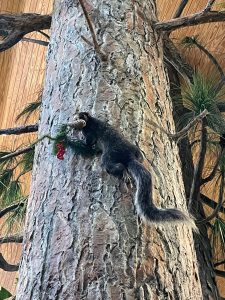
Two weeks ago, I saw my first foxes in the wild. A week and a half ago, I saw my first fox squirrel (Sciurus niger)! While unrelated, the ecology geek in me loved the unlikely coincidence. I saw the fox squirrel as we were leading a kayaking trip down Thompson’s Bayou, just off the University of West Florida campus. Out of the corner of my eye, I noticed something large scampering through the treetops along the water. The sound and extent of movement made me think it was much larger than your average squirrel. Ruling out a monkey—although you can see monkeys kayaking down Silver Springs State Park—a member of our group suggested it was a fox squirrel. On closer inspection, this was correct. Larger than a common gray squirrel, the fox squirrel’s long body seemed more like an otter high in the trees. It stayed a while within our view, sitting in a high branch overlooking the bayou.

While native to our area, fox squirrel sightings are relatively rare. The are more widespread to our north in Alabama, but their prime habitat is longleaf pine forest. The southeast’s multi-million-acre longleaf ecosystem has dwindled to just 2% of its original existence, therefore fox squirrels are fewer in number. There are fewer red-cockaded woodpeckers, gopher tortoises, and indigo snakes, too, but I’ll leave them for another day.

The fox squirrel has a diverse diet, ranging from seeds and acorns to fungi, bird eggs, and fruit. However, they prefer pine seeds when available. They obtain water by licking dew from plants or ingesting succulent plants. Fox squirrels are mostly black in coloration, although they typically have streaks of silver and reddish orange in their torsos and tails. They are relatively large—their bodies are 12-15 inches long, with their tails equally as long. They often weigh up to 3 pounds. In contrast, the average gray squirrel is 16-20” long (including the tail) and weigh half as much. Biologists hypothesize that their large bodies allow them to go longer without food, handle bigger pine cones, and manage larger territories. They have strong hind legs and can leap significant distances.
Fox squirrels typically rear two broods of young each year and dwell in tree-based nests or cavities. Outside of breeding season, adults are typically solitary animals. Research in Alabama has shown the average male fox squirrel maintains a territorial area of 94 acres, with females living among 29 acres. This solitary nature may account for why fox squirrels are seen less often than gray squirrels. While rarely seen, they are not considered threatened or endangered species. Like most native wildlife species, however, habitat destruction and development have led to reductions in their overall populations.
 6
6
